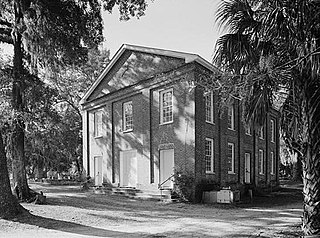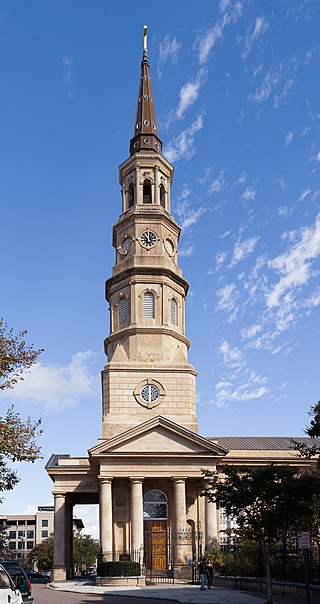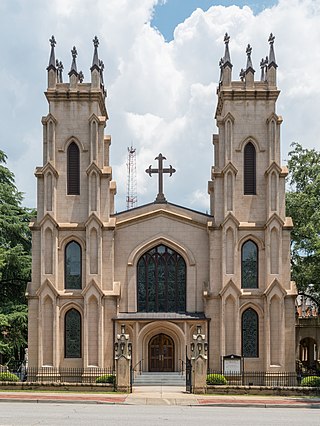
The Old State House, formerly called the Arkansas State House, is the oldest surviving state capitol building west of the Mississippi River. It was the site of the secession convention, as well as the fourth constitutional convention when delegates agreed to ensure voting rights for freedmen and establish public education.

The South Carolina State House is the building housing the government of the U.S. state of South Carolina, which includes the South Carolina General Assembly and the offices of the Governor and Lieutenant Governor of South Carolina. Located in the capital city of Columbia near the corner of Gervais and Assembly Streets, the building also housed the Supreme Court until 1971.

John Lawrence Manning was the 65th Governor of South Carolina, from 1852 to 1854. He was born in Clarendon County. He attended South Carolina College, where he was a member of the Euphradian Society.

The Old Campus District, University of South Carolina, is a historic district centered on The Horseshoe on the main campus of the University of South Carolina in Columbia, South Carolina. On June 5, 1970, it was listed in the National Register of Historic Places. On April 19, 1996 MTV Unplugged filmed Hootie & the Blowfish's concert on The Horseshoe before the release of their second album Fairweather Johnson.

The Chappelle Administration Building, on the campus of Allen University in Columbia, South Carolina, was designed by John Anderson Lankford, known as the "dean of black architects." The building name has been spelled Chapelle Administration Building in HABS and NPS reports. It was declared a National Historic Landmark in 1976, cited as one Lankford's most important works.

The Penn Center, formerly the Penn School, is an African-American cultural and educational center in the Corners Community, on Saint Helena Island. Founded in 1862 by Quaker and Unitarian missionaries from Pennsylvania, it was the first school founded in the Southern United States specifically for the education of African-Americans. It provided critical educational facilities to Gullah slaves freed after plantation owners fled the island, and continues to fulfill an educational mission. Leigh Richmond Miner photographed students and activities at the school.

Millford Plantation is a historic farmstead and plantation house located on SC 261 west of Pinewood, South Carolina. It was sometimes called Manning's Folly, because of its remote location in the High Hills of Santee section of the state and its elaborate details. Designated as a National Historic Landmark, it is regarded as one of the finest examples of Greek Revival residential architecture in the United States. The house has been restored and preserved along with many of its original Duncan Phyfe furnishings.

Temple Sinai is an historic Reform synagogue located at 11 Church Street on the corner of West Hampton Avenue, in Sumter, South Carolina, United States. Built in 1912 of brick in the Moorish Revival style, Temple Sinai was added to the National Register of Historic Places on January 21, 1999. It is also known as Congregation Sinai, whose official name is the Sumter Society of Israelites. It also houses the Temple Sinai Jewish History Center which opened in June 2018.

St. Philip's Church is an historic church at 142 Church Street in Charleston, South Carolina. Its National Historic Landmark description states: "Built in 1836, this stuccoed brick church features an imposing tower designed in the Wren-Gibbs tradition. Three Tuscan pedimented porticoes contribute to this design to make a building of the highest quality and sophistication." On November 7, 1973, it was added to the National Register of Historic Places and designated a National Historic Landmark.

The Stateburg Historic District is a historic district in Stateburg, in the High Hills of Santee area near Sumter, South Carolina in the United States. It includes two National Historic Landmarks, Borough House Plantation and the Church of the Holy Cross, and at least eight contributing properties within its boundaries. On February 24, 1971, it was added to the National Register of Historic Places. The historic district extends north and east of the town of Stateburg as far north as Meeting House Road and as far east as South Carolina Highway 441, covering an area of 5,066 acres (20.50 km2).

The High Hills of Santee, sometimes known as the High Hills of the Santee, is a long, narrow hilly region in the western part of Sumter County, South Carolina. It has been called "one of the state's most famous areas". The High Hills of Santee region lies north of the Santee River and east of the Wateree River, one of the two rivers that join to form the Santee. It extends north almost to the Kershaw county line and northeasterly to include the former summer resort town of Bradford Springs. Since 1902 the town has been included in Lee County.

This is a list of the National Register of Historic Places listings in Richland County, South Carolina.

Rose Hill Plantation State Historic Site is a historic site in Union County, South Carolina, that preserves the home of William H. Gist (1807-1874), the 68th governor of South Carolina. Gist helped instigate a Secession Convention in South Carolina, which led to the creation of the Ordinance of Secession that preceded the Civil War.

Trinity Episcopal Church, now known as Trinity Episcopal Cathedral, is the first Episcopal and the oldest surviving sanctuary in Columbia, South Carolina. It is a Gothic Revival church that is modeled after York Minster in York, England. It was named to the National Register of Historic Places on February 24, 1971.

The First Presbyterian Church is a historic church building in Columbia, South Carolina. Constructed in 1854, it was added to the National Register of Historic Places on January 25, 1971.

Ladson Presbyterian Church is a historic African American Presbyterian church located at 1720 Sumter Street in Columbia, South Carolina. The religious building was initially a chapel founded in 1838 and, rebuilt in 1896, and is a one-story-over-raised-basement, rectangular red brick building in the Renaissance Revival style. It has a front gable roof and features two brick entrance towers. The congregation was founded in 1838, as an offshoot congregation of the First Presbyterian Church.

The Washington Street United Methodist Church is a historic church at 1401 Washington Street in Columbia, South Carolina.

Town Theatre is a historic community theatre located at Columbia, South Carolina. It was built in 1924, and is a rectangular brick building with a two-story glazed central arch with Art Deco influences. A brick annex was added to the rear of the building in the 1950s. It houses one of the first community theatres in the United States.

Wade Hampton State Office Building is a historic state office building located at Columbia, South Carolina. It was built between 1938 and 1940, and is a large six-story building in a restrained Neoclassical style, with Art Deco inspired details. It held the offices of the Attorney General and the Department of Education, who embodied the state's policy of racial segregation. The building was also designed with segregated spaces for African American patrons conducting business there.

Allen University Historic District is a historic district in Columbia, South Carolina that includes buildings on the campus of Allen University, originally established as Payne Institute. Buildings in the district include Arnett Hall, the Chappelle Administration Building, Coppin Hall, the Joseph Simon Flippen Library, and the Canteen Building. The district was listed on the National Register of Historic Places April 14, 1975. The address is 1530 Harden Street. Originally in a suburb, the university is now near downtown.
























